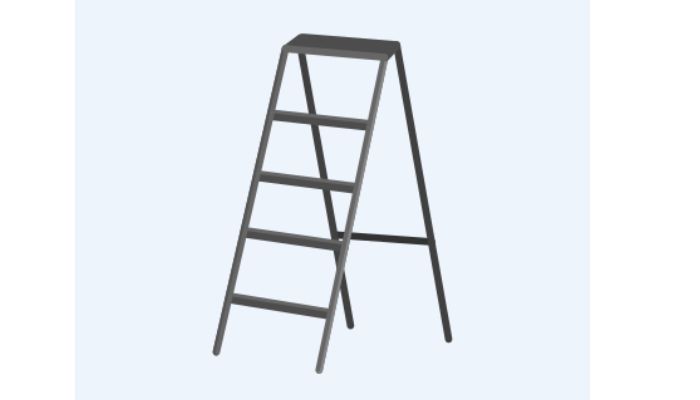Ladders are essential tools for many DIY jobs and projects, but how much weight can a ladder really hold?
Knowing your ladder’s maximum load capacity is key to ensuring that you don’t overload it and put yourself in danger.
This article will review the ladder use safety guidelines and discuss the available ladders and their maximum load capacities.
With this knowledge, you’ll be able to make sure you’re using your ladder safely while accomplishing any task!
Safety Guidelines for Ladder Use
Before using a ladder, it is important to review safety guidelines and practice proper ladder-use techniques. These include:
- Only climb the ladder with two feet and two hands on the steps or rungs at all times,
- Ensure to keep your belt buckle between the rails of the ladder when climbing, not overreaching while on the ladder
- Use the 4-to-1 rule (the ladder’s base should be approximately four feet away from the wall or object it is leaning against for every one foot of height).
Types of Ladders and Their Maximum Load Capacities
Now that you understand the safety guidelines for ladder use, let’s review the different types of ladders available and their respective maximum load capacities.
Step Ladders

Most step ladders are rated to hold up to 250 pounds, with some holding up to 300 pounds. Make sure your step ladder is in good condition and ensure that the locks are secure and the steps are not cracked.
Extension Ladders

Extension ladders typically have a maximum load capacity of 300 to 375 pounds, depending on the size and style of the ladder.
Make sure your extension ladder is in good condition and properly extended before using it, as an improperly extended ladder may not be able to support the rated load capacity.
A-Frame and Multi-Position Ladders
These ladders typically have a maximum load capacity of 300 to 375 pounds, depending on the size and style of the ladder.
Ensure your A-frame or multi-position ladder is in good condition before using it, as an improper setup ladder may not support the rated load capacity.
By following the safety guidelines and understanding the maximum load capacities of different types of ladders, you can make sure that you are using your ladder safely and effectively for any job or project.
Tips for Using a Ladder Safely
In addition to following the safety guidelines and understanding the maximum load capacities for different types of ladders, there are also some additional tips you can use to ensure you’re using your ladder safely.
- Ensure that the area around the ladder is free from any tripping hazards, such as tools or power cords, and never stand on the top two rungs of a ladder.
- Make sure to inspect your ladder before use to check for any damages or worn-out parts
- Be sure to read the instructions that come with the ladder.
Benefits of Knowing the Maximum Load Capacity of Your Ladder
Knowing the maximum ladder weight capacity is essential to ensure that you don’t overload it, which can lead to serious injuries or even death.
Additionally, understanding the safety guidelines and tips for using a ladder safely will give you the confidence to use your ladder effectively and efficiently while avoiding any potential dangers.
With this knowledge, you’ll be able to make sure you’re using your ladder safely so that you can get any job or project done with ease.
Common Mistakes to Avoid When Using a Ladder
Know the basics – steer clear of these common errors to avoid a serious ladder accident and ensure success.
- Never stand on the top two rungs or use the top of the ladder as a shelf, as this can lead to an imbalance and potential injury.
- Never leave your ladder unattended while in use
- Ensure all locks are secure.
- Never stand on wobbly or loose ladders (especially if it’s a wood ladder.)
How to Choose the Right Type of Ladder for Your Project
Now that you know the safety guidelines and maximum load capacities of different ladders let’s discuss how to choose the right type of ladder for your project or job.
- Step ladders are best suited for smaller tasks like painting or minor repairs.
- Extension ladders are perfect for reaching higher heights, such as when you’re cleaning out gutters or installing a satellite dish.
- A-frame and multi-position ladders are great for tasks that require an adjustable working platform, such as hanging pictures or light fixtures.
How to Use a Ladder Stabilizer
A ladder stabilizer is invaluable for those who often use a ladder around the house. It helps to ensure your ladder won’t slip and slide during use, particularly when you are on uneven surfaces like gravel or grass.
To get the most out of your stabilizer, follow these easy steps:
- Push down firmly on each end so that it creates a stable base.
- Align your ladder with the gap between them and open up the arms wide, so they rest securely against your ladder’s stiles.
- Remember that the floor must be level and solid, as the stabilizer functions best when it has adequate footing to hold it in place.
Frequently Asked Questions (FAQs)
What is the 1 in 4 rule for ladders?
The 1 in 4 rule states that for every four feet of a ladder’s height, the base must be one foot away from the place where it rests.
How much weight can a Type I Ladder hold?
Type I ladders can typically hold up to 250 pounds. It is important to keep in mind that the weight capacity of a ladder may also depend on the construction and materials used, as well as other factors such as environmental conditions or usage.
How much weight can a Type II ladder hold?
A Type II ladder usually holds up to 225 pounds without losing stability or sturdiness. However, it’s easy to check the manufacturer’s label on the product to find the exact weight capacity, so you’ll know that you’re choosing a ladder that can meet your needs. The Little Giant Ladder company is a great resource for this.
What is the 3-point rule for ladders?
The 3-point rule states that for safe climbing, you should always maintain three points of contact on a ladder. This ensures safety and stability for yourself and the ladder and prevents slips and falls that can cause serious injury or property damage. The three points of contact are very distinct; two hands gripping the rails and one foot secure on a step.
Can you stand on the top 3 rungs of a ladder?
The general rule of thumb is to stay off the top 2 steps and limit your reach while standing elsewhere. Not only do you lack support from anything above your waist, but you must also remember that ladders can shake when put under pressure. This means an unnecessary risk for yourself and anyone beneath you.

